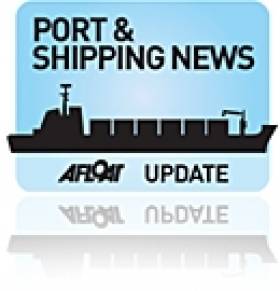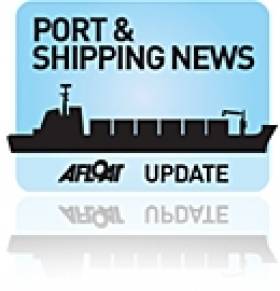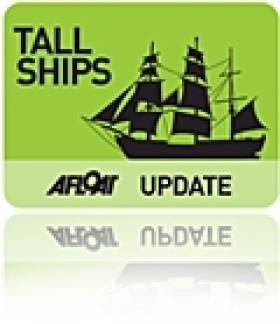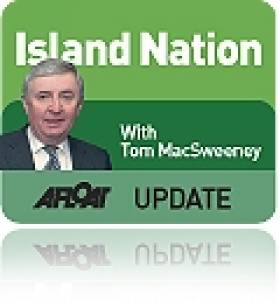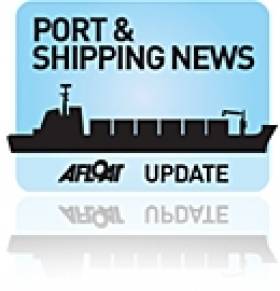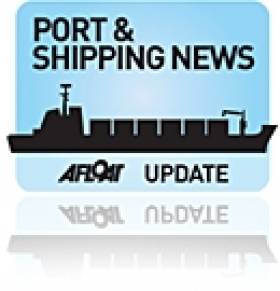Displaying items by tag: Ports
Ireland Risks Missing Out On Renewable Energy Benefits
Ireland must do more to develop its port and shipping services or risk missing out on the benefits of the growning renewable energy sector.
That was the message from a new analysis compiled by the Sustainable Energy Authority of Ireland and the Irish Maritime Development Office, as reported by Renewable Energy Magazine.
The current lack of supply services and equipment for renewables in Irish ports could threaten the country's promise in the fields of offshore wind, tidal and wave energy, the report states.
It is estimated that the total value of such renewable energy sectors could be as much as €16 billion.
The east coast has been identified as the best location for offshore wind and tidal projects, while the south and west coasts were best for wave power and wind farms.
“We now need to look at the investment in infrastructure required if we are to properly capitalise on the current opportunities in this area," said the report.
Renewable Energy Magazine has more on the story HERE.
Shipping Volumes Up in First Quarter
First quarterly figures for 2011 show that volumes of shipping and port traffic on the majority of principal sectors grew, according to the Irish Maritime Development Office (IMDO).
The figures below outline a moderate trade volume growth in four out of the five key freight segments: Lift-on/ lift-off (lo-lo), Roll-on/Roll-off (ro-ro),dry-bulk, break-bulk and the tanker/liquid market.
• Total lift-on/ lift-off (lo/lo) trades volumes grew by 3%.
• Roll-on/Roll-off export traffic was also up 2% per cent on an all island basis.
• Dry bulk volumes through ROI ports increased by 21%,
• Breakbulk volumes were also up 25%
• The tanker/liquid market was the only sector to record a decline, down by -12% compared to the same period last year.
For further information about the figures, charts and a summary released from the IMDO click here
The McCarthy Report on Seaport Recommendations
The McCarthy Report: Recommendations on Seaports and Port Industry Structure reviews statistical and port data analysis based from the Irish Maritime Development Office (IMDO) financial analysis of the ports sector in 2010.
To read in greater detail the main conclusions and recommendations click here.
Check the latest ports and shipping news
The report shows that unitised traffic on the main Roll-on/Roll-off routes to the UK recovered by 4% in 2010, with a decline in the Lift-on/Lift-off container sector easing substantially compared to the 2009 with a fall of just 3%.
The strongest volume recovery occurred in the dry bulk segments which were up 18% Part of the return to growth in this sector is attributed to strong global demand for ore and mineral products such as alumina, while domestic demand in the agricultural sector led to a rise in the imports of grains, feeds and fertilizers. Although the overall picture is positive; the main volume gains in this segment were not evenly distributed among the ports with some of the smaller regional ports still in negative territory for the year. Tanker and liquid bulk volumes were up 2%, while ferry passenger volumes also increased for the full year by 4%.
"We have seen many ports and shipping segments recover some of the heavy losses which occurred over the past two years," said IMDO Director Mr. Glenn Murphy. "The trend in shipping data appeared to closely follow the general economic climate last year with a strong start to 2010, before wider economic concerns over the third quarter contributed to the general slow down at the year end."
The report also highlights the continued resilient performance of export trades with estimates that export volumes on the principle routes to the UK, Asia and US were up overall by 7%. The underlying performance of multinational sectors, principally in chemical and pharmaceutical industries, led the export recovery while established indigenous Irish exporting companies, particularly in the food, drink and agri-business segments , also contributed to the strong performance. The report remarks however that imports in the principle segments linked to consumer and household demand remained subdued last year with no noticeable growth.
The report concluded that outlook for 2011 looks likely to be testing for the domestic ports and shipping sectors with less growth forecast across the majority of the shipping segments. The rise of bunker/fuel prices by 136% over the past 12 months will put further pressure on operators to increase freight rates and bunker surcharges. The full report can be read here.
Hamburg Gets Ready to Host World's Biggest Ports Festival
Billed as the world's greatest Port Festival, five of the world's largest and most beautiful tall ships – and at least one, the Mir, is also entered for the Tall Ships race in Waterford in June – have announced their presence at Hamburg next month.
Also coming to Hamburg is the Dar Mlodziezy, the Kruzenshtern, the Mir, the Sedov and the Sea Cloud. Each of these classic sailing ships, at home on the oceans of the world, is more than 100 metres in length, and captures the romance of maritime life.
The HAFENGEBURTSTAG HAMBURG has a thing or two to show off about given its large fleet of boats and Tall Ships that are gathering this year for the 822nd time. It's an opportunity to for Irish port festivals aiming to exploit the marine leisure resources around the Irish coastline.
The Sea Cloud, built in Kiel in 1931, and the largest private yacht in the world at the time, will be present at HAFENGEBURTSTAG HAMBURG for the first time, back in Hamburg for the first time in 33 years.
In Hamburg, there will be tall ships and cruise vessels, naval ships and emergency service boats, heritage and museum ships, sailing and motor yachts, dragon boats, and even a Roman galley. Altogether more than 300 vessels from the seven seas will be taking part, on display in their element before the fantastic backdrop of Hamburg's Landing Stages (Landungsbrücken) from 6 to 8 May at the world's greatest Port Festival.
The port is more lively than ever on the three days of HAFENGEBURTSTAG HAMBURG", says Captain Jörg Pollmann, in eager anticipation. "All those different ships and displays on the Elbe combine to form a unique celebration, which brings more than a million visitors to the Port of Hamburg every year." The guests from Germany and abroad can look forward to a superlative programme on the water, starting with the Grand Arrival Parade from 16:30 on Friday 6 May, and ending with the Grand Departure Parade at 17:30 on Sunday 8 May. There are also plenty of maritime attractions at the Oevelgönne Heritage Harbour and at the HafenCity traditional maritime harbour.
Meeting of the luxury liners
Visitors are warned that watching the six cruise ships arriving and departing on the three days of HAFENGEBURTSTAG HAMBURG may cause itchy feet and severe travelitis! The AIDAcara, AIDAblu and Mein Schiff 2 will be arriving on the Friday, the Amadea and the Fram, an expedition ship from Norway, will follow on the Saturday. And to top it all, the Queen Mary 2 will call in Hamburg on the Sunday. Costa Crociere, Europe's largest cruise ship operator, has just chosen Hamburg as the new home port for its cruise ship Costa Magica, and will join in the celebrations, sponsoring the great Costa Cruises Firework Display at 22:30 on Saturday 7 May, lighting up the night sky over the Elbe.
International navy visit and maritime adventurer from Norway
The world's greatest Port Festival traditionally brings a large naval contingent from Germany and elsewhere to Hamburg. From Germany there will be the frigate Sachsen, the fast patrol boat Hermelin and the mine hunters Homburg and Hameln. Norway, the partner country of HAFENGEBURTSTAG HAMBURG, will be represented by the frigate Otto Sverdrup, and Belgium by the mine hunters Crocus and Primula.
Norway, the partner country for this year's HAFENGEBURTSTAG HAMBURG, is also sending vessels of various designs and uses to visit Hamburg. The Arctic sailing ship Berntine will welcome visitors on board in the HafenCity Traditional Harbour. She was built at the Tromsøer shipyard in 1890 and restored several times since then. Sjøkurs is a training ship, built by the Hamburg shipyard Blohm & Voss in 1956 as the Postal Vessel Ragnvald Jarl. Today she accommodates 60 cadets on board, and travels around Norway and to other countries about ten weeks per year. The Fram, an expedition ship, will moor at the Hamburg Cruise Center in HafenCity. She is the latest addition to the Hurtigruten fleet and was christened by Norway's Crown Princess Mette Marit on 16 May 2007.
On duty for safety and security
The challenges of work on the high seas will be demonstrated by a range of modern working vessels from the fire services, fisheries protection, THW emergency services, the waterways police and the customs. The rescue cruiser John T. Essberger, owned by the German Lifeboat Institution DGzRS, will make its final appearance at HAFENGEBURTSTAG HAMBURG before decommissioning. It will then start on its final voyage to the Technical Museum of Speyer, where it will in future be moored as a museum vessel.
Dancing tug boats and heritage ships
One of the traditional highlights of the maritime programme is the unique Tug Boat Ballet at 17:00 on the Saturday, when the 5000 hp working tugboats perform their pirouettes on the Elbe.
A fleet of classic steamships will give a special birthday greeting from the Oevelgönne Heritage Harbour when they pass the Landing Stage at 16:00 on the Saturday, "full steam ahead" – not only puffing out clouds of smoke from their chimneys, but also releasing balloons from their decks.
On-board visits
Many of the vessels at HAFENGEBURTSTAG HAMBURG, including the tall ships and naval units, will hold Open Days for visitors to look around on board. Many of the launches and passenger ships also invite visitors to HAFENGEBURTSTAG HAMBURG to go on board and join in the Parades, or to tour the vessel.
Giving Away a Billion from the Sea
I had to read the figures twice to make sure that I was seeing them correctly. The second reading made me even more angry than the first.
They were, at last, a definitive figure of how much the stupidity of Irish politicians and the ignorance and disregard of the maritime sphere by the Government have cost this nation – over a billion Euros in one year.
There is no way the Government can weasel its way out of this revelation, nor any excuse the un-named civil servants responsible can make to avoid the accusation that this is a massive economic waste.
The Marine Institute is the Government's own respected authority on maritime affairs, the voice of the State on marine research and it has valued the total available catch of fish off Ireland last year at €1.18 billion, for a total of 994,155 tonnes.
That is an enormous figure, indicating huge potential wealth for this cash-strapped nation in the middle of an economic disaster. But of this total value of seafood, Ireland was only entitled to catch €0.19 billion. Foreign fishing fleets had exclusive rights to take the rest of the fish from Irish waters.
No wonder I had to read the figures a second time to make sure I was seeing them correctly at a time when the value of our food exports has been shown to be one of the top earners for the nation. How much more could have been earned if Irish fishermen could catch all that fish and have it processed in Ireland, creating onshore jobs in ancillary businesses as well as at sea?
The total value for 2010 could be even higher than €1.18 billion because the Institute prepared its figures in advance of the annual fisheries negotiations in Brussels in December. Ireland as a nation and the country's fishing industry in particular are likely to have lost out even more heavily to other EU countries.
Effectively, Ireland handed over around €1billion of its natural economic resources to other EU countries. Mark McCarthy, Editor of The Marine Times, the national fishing industry paper, described the figures as "truly frightening."
"This is a nation with some of the richest fishing grounds in the world where the coastal communities are being financially starved and frustrated through their inability to catch their own fish, because they are not allowed to do so."
It is hardly any wonder that Irish fishermen, forced to tie up their boats at the quaysides of Irish fishing ports and watch as foreign vessels unload into those ports, are bitter and frustrated.
Ebbie Sheehan of Castletownbere, Chairman of the Irish Fishermen's Organisation, asks why fishermen are "so badly treated when we look at the economic situation today?"
The Marine Institute, our national maritime scientific and research organisation, says that its estimate of the value of fishing opportunities in Irish waters is "conservative" and that, in order to prepare the figures in early December, it based them on 2009 values
That would make the total value even higher and the Institute pointed out that of the total catch of 994,155 tonnes, Ireland's fishermen were entitled to take only 18 per cent of the catch. This was only 16 per cent of the total value.
"These figures exclude valuable inshore fisheries, such as lobster and whelk which are not currently managed by total allowable catches within the Common Fisheries Policy," the Institute pointed out.
As Mark McCarthy described it, when one considers the importance of using our natural resources for the benefit of Irish people and the failure of our political leaders to see and understand this, what has been revealed is "truly frightening".
- This article is reprinted by permission of the EVENING ECHO newspaper, Cork, where Tom MacSweeney writes maritime columns twice weekly. Evening Echo website: www.eecho.ie
Delegates Discuss Shortsea Shipping Sector in Dublin
Two hundred delegates, including many of Europe's senior port and shipping executives, gatheredfor the Annual European Shipping Congress at Dublin Castle, today (29th, June 2010) to discuss the current state of the European Shortsea shipping and port sector.The event, which was organised by the Irish Maritime Development Office (IMDO) was formally opened by Minister Ciaran Cuffe, Minister of State at the Department of Transport. The theme of the Congress was "strategies and opportunities for recovery in European Shortsea Shipping".Speaking at the conference Mr Fran Dodd, Logistics Manager of the Irish Dairy Board said "Competitive shortsea shipping has been fundamental to our success and is fundamental to our future" IDB export 100% of their products, including Kerrygold brand to over 80 countries worldwide.
Major Irish exporting companies such as Irish Dairy Board, Wellman International and Rusal, (the worlds largest alumina and aluminium producer with a major facility in on the Shannon Estuary), all provided key note papers on their perspective for export led recovery."This year's congress is taking place at a time when the industry is still concerned about the pace and fragility of the recovery in the European economic zone, said IMDO Director Glenn Murphy. "The European shipping sector has endured a highly turbulent 18 months which has seen shipping demand and port throughput fall right across Europe. This has resulted in most market segments having to deal with capacity issues and falling freight rates. The Congress appears optimistic but still highly cautious of the volatile nature of the recovery path for the sector"In his opening address Minister Cuff welcomed that Ireland had become a recognised location where leaders from across Europe now come to regularly discuss key shipping and port issues. "I am particularly pleased to note that, although issues such as cost and capacity where very much to the fore of the industry agenda, highly important areas such as climate change and vessel emissions were also being debated at the congress," he said.
The European Shipping Congress is now scheduled to be held in Ireland every alternate year and is scheduled to return in 2012 after being hosted in Germany in 2011.
Two hundred delegates, including many of Europe's senior port and shipping executives, gatheredfor the Annual European Shipping Congress at Dublin Castle, today (29th, June 2010) to discuss the current state of the European Shortsea shipping and port sector.
The event, which was organised by the Irish Maritime Development Office (IMDO) was formally opened by Minister Ciaran Cuffe, Minister of State at the Department of Transport. The theme of the Congress was "strategies and opportunities for recovery in European Shortsea Shipping".
Speaking at the conference Mr Fran Dodd, Logistics Manager of the Irish Dairy Board said "Competitive shortsea shipping has been fundamental to our success and is fundamental to our future" IDB export 100% of their products, including Kerrygold brand to over 80 countries worldwide.
Major Irish exporting companies such as Irish Dairy Board, Wellman International and Rusal, (the worlds largest alumina and aluminium producer with a major facility in on the Shannon Estuary), all provided key note papers on their perspective for export led recovery.
"This year's congress is taking place at a time when the industry is still concerned about the pace and fragility of the recovery in the European economic zone, said IMDO Director Glenn Murphy. "The European shipping sector has endured a highly turbulent 18 months which has seen shipping demand and port throughput fall right across Europe. This has resulted in most market segments having to deal with capacity issues and falling freight rates. The Congress appears optimistic but still highly cautious of the volatile nature of the recovery path for the sector"
In his opening address Minister Cuff welcomed that Ireland had become a recognised location where leaders from across Europe now come to regularly discuss key shipping and port issues. "I am particularly pleased to note that, although issues such as cost and capacity where very much to the fore of the industry agenda, highly important areas such as climate change and vessel emissions were also being debated at the congress," he said. The European Shipping Congress is now scheduled to be held in Ireland every alternate year and is scheduled to return in 2012 after being hosted in Germany in 2011.
The latest figures from the Irish Maritime Development Office (IMDO) on Irish shipping and port traffic data for the first quarter of 2010 indicate a continued general easing in the rate of decline in freight volumes. The IMDO estimate that 2 of the principal 5 freight segments measured indicated modest growth over this period. However while the rate of decline has moderated the overall recovery has been uneven both in the mode of transport and also the distribution of traffic around the island with larger gateway ports on average performing better than smaller regional ports. The first quarter data is also slightly skewed by significant weather disruption which occurred over the first 4 weeks of the year which is likely to have impacted on several key trades.
Roll-on/roll-off (ro/ro) traffic on an all-Island basis grew 5% in the first quarter 2010 when compared to Q1 2009. The Ro/RO segment is largely weighted towards services to and from the UK. Traffic movements on these corridors have been less exposed to the downturn in construction based inventories but connected to longer establish trading segments.
Lift-on/lift-off (lo/lo) traffic through Irish ports declined 7% in the 1st quarter, when compared to the same period in 2009 with 239,643 units being handled at all Irish ports. Lo/Lo volumes have historically been driven by imports linked to strong domestic and residential demand. Import volumes fell again by 9% but the decline is less severe than the 27% fall in the corresponding period in 2009. Laden container exports were down 1% which again compares positively to the 21% decline 12 months earlier and supports general optimism of an export led recovery. Export volumes are likely to have also been impacted by the poor weather conditions in January and might otherwise have been stronger. Lo/Lo volumes likely to only recover at a slower pace as concerns about retail consumer sentiment prevail. Incumbent operators have continued to reduce the supply of shipping capacity made with an increase in vessel sharing arrangements between operators and further consolidation of routes occurring in the early part of the year.
Volumes in the key bulk sectors appeared to move towards recovering from the record volume declines in 2009 where more than 33% of total volume was lost. Total bulk volumes through ROI ports fell just 1% in the first three months of 2010 with dry bulk volumes down 2% although with some recovery observed figures in fertilizers and aggregates to 3.05million tonnes while liquid bulk volumes grew by 1% helped by the cold weather period. Breakbulk volumes linked to construction inventories declined by 20% to 63,000 tonnes with limited prospects of a return to previous volumes seen in 2007 when the corresponding figure was 160,00 tonnes.
As highlighted earlier, there is no doubt that overall freight traffic volumes were impacted by the significant weather disruption caused to trade and manufacturing output. We also observed certain re-distribution of traffic volumes between ports over the past quarter. While some key segments recorded negative growth the rate of volume erosion is still substantially less than 12 months earlier when large amounts of tonnage capacity dissipated as the sector adjusted abruptly to the change in the economy.
The fundamentals in terms of the number of shipping companies active and competing for market share in the principal Irish freight markets is still strong. The outlook for short term volume recovery remains largely contingent on the continued external recovery in the global economy. A weaker euro is also likely to boost our export potential to major overseas markets, however oil and bunker prices have continued to steadily rise during the first quarter and will also be marginally more expensive in dollar terms.
Irish ships will now be considered of the highest quality and will be subject to less inspections in ports throughout the region following an international meeting in Dublin today.
The Paris Memorandum of Understanding on Port State Control (Paris MoU) held its 43rd Committee meeting in Dublin, Ireland from 10 - 14 May 2010. The meeting was held in the Dublin Castle Conference Centre and was opened by Minister of Transport Mr Noel Dempsey TD. The meeting was chaired by Mr. Brian Hogan (Chief Surveyor of the Marine Survey Office), at the Department of Transport.
The Paris MoU adopted the new "Black/Grey/White List" which is the international league table of maritime flag states. Ireland is on the white list of best performing States and moved from 19th on the list to 8th place this year. This means that Irish ships will now be considered of the highest quality and will be subject to less inspections in ports throughout the region. This will have positive financial consequences for the Irish shipping industry.
The meeting adopted the "New Inspection Regime" (NIR), which is a groundbreaking development in Port State Control. The New Inspection Regime, which will enter into force from 1 January 2011, and will replace the existing Port State Control system. The NIR was developed following a process of review of the existing Port State Control mechanism. The NIR is a significant departure as it is a risk based targeting mechanism, which will reward quality shipping with a smaller inspection burden and concentrate on high-risk ships, which will be subject to more in-depth and more frequent inspections. The NIR is based on the latest developments at the International Maritime Organization, IMO, and makes use of company performance and the IMO audit for identifying the risk profile of ships together with the performance of the flag State and the recognised organisation. The past inspection record of the ship as well as the ship's age and ship type will influence the targeting. Full implementation of the system will rely on collection of port call information. The NIR will be accompanied by a new information system "THETIS" which will replace the current SIReNaC information system.
The Committee looking ahead and recognising that the International Labour Organisation's Consolidated Maritime Labour Convention, 2006, MLC 2006, may enter into force from 2011 onwards considered draft guidelines for Port State Control Officers in respect of the implementation of the Port State Control requirements of the Convention. These guidelines will be based on the MLC 2006 and should become a practical tool for inspections on working and living conditions and will ensure that seafarers will be protected. The Committee also adopted new guidance on control of International Safety Management, ISM, Code requirements, taking into account experience gained since the entry into force of the ISM Code. The Committee continued to take actions in response to the 2nd Joint Paris/Tokyo MoU Ministerial Conference, held in Vancouver in 2004 and agreed that all actions have been completed or will be monitored on a continuous basis.
The results of the Concentrated Inspection Campaign on Lifeboat Launching Arrangements were considered by the Committee and it was agreed that the evaluation will be submitted to the International Maritime Organization in 2011. From September to November this year the Paris MoU will focus its campaign on damage stability of oil tankers, which is seen as an important issue and the results will be communicated to the international shipping community.
The Paris MoU has increasing relations with port State control regimes in other areas of the world. The meeting heard reports from the US Coast Guard, the Caribbean MoU, Black Sea MoU, Riyadh MoU and Tokyo MoU. The International Labour Organization was also represented and provided updates. Malta and Croatia will join the MoU Advisory Board (MAB) of the Paris MoU for the coming 3 years and the Committee thanked the outgoing MAB members Russian Federation and Sweden for their positive contributions over the past period.
ENDS
Demand for Ferry Travel Trebles During Aviation Crisis
73% of the traffic moved through the principal gateways along the central corridor with record numbers of passenger moving through Dublin Port. Elsewhere, similar increased demand was catered for by operators at Rosslare (23% share of traffic), while the new service from Cork also provided additional capacity and distribution to the south of the island.
Commenting on the numbers IMDO Director Glenn Murphy said “The measured and co-ordinated response of all ferry operators, port companies and other transport providers to this surge in demand has been exceptional. There was clearly excellent co-operation between the various groups in their response to this national situation, which was undertaken in an efficient and professional manner at a time when it was most needed.”
Ports and shipping lines provided added additional shuttle bus services to facilitate the surge in the numbers of foot passengers seeking to travel while ferry companies also endeavoured to ensure that all passengers were accommodated during the disruption, with sailings delayed to allow additional time to board the extra passengers.
The National Emergency Co-ordinating Committee also acknowledged the response of the ferry operators and ports in their efforts to relieve the pressures caused by the aviation crisis. The Taskforce noted there had been no increase in ferry passenger charges, despite the massive increase in demand. The constructive and proactive engagement of the ferry operators over the past few days is to be complimented.
Sailings are still running at high capacities on all main gateways, although there is still availability on most routes. Demand levels are expected to return to more normal seasonal levels over the course of next week. These figures come against the background of figures for the full year, recently reported by the IMDO which illustrated that passenger numbers remained constant during 2009 with no fall off in passenger volumes recorded despite the difficult economic conditions.



























